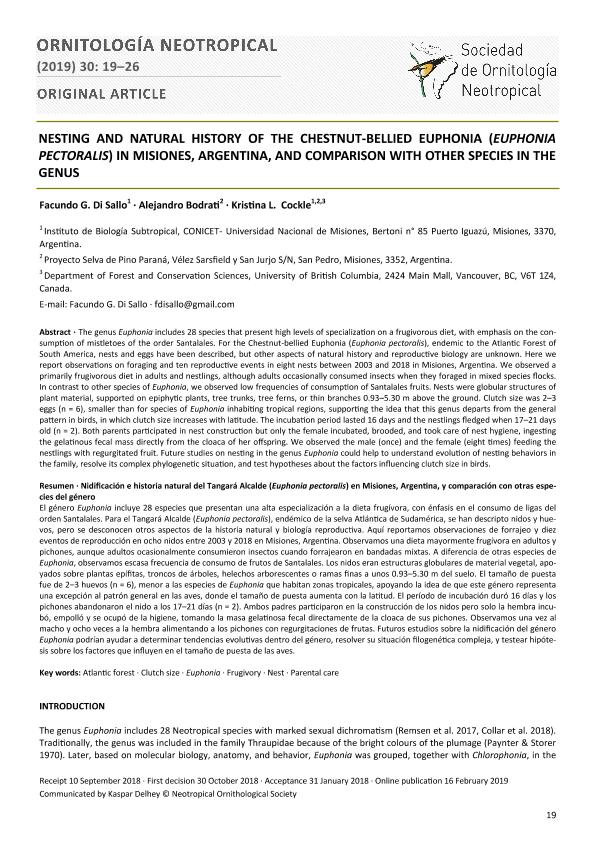Artículo
The genus Euphonia includes 28 species that present high levels of specialization on a frugivorous diet, with emphasis on the consumption of mistletoes of the order Santalales. For the Chestnut-bellied Euphonia (Euphonia pectoralis), endemic to the Atlantic Forest of South America, nests and eggs have been described, but other aspects of natural history and reproductive biology are unknown. Here we report observations on foraging and ten reproductive events in eight nests between 2003 and 2018 in Misiones, Argentina. We observed a primarily frugivorous diet in adults and nestlings, although adults occasionally consumed insects when they foraged in mixed species flocks. In contrast to other species of Euphonia, we observed low frequencies of consumption of Santalales fruits. Nests were globular structures of plant material, supported on epiphytic plants, tree trunks, tree ferns, or thin branches 0.93–5.30 m above the ground. Clutch size was 2–3 eggs (n = 6), smaller than for species of Euphonia inhabiting tropical regions, supporting the idea that this genus departs from the general pattern in birds, in which clutch size increases with latitude. The incubation period lasted 16 days and the nestlings fledged when 17–21 days old (n = 2). Both parents participated in nest construction but only the female incubated, brooded, and took care of nest hygiene, ingesting the gelatinous fecal mass directly from the cloaca of her offspring. We observed the male (once) and the female (eight times) feeding the nestlings with regurgitated fruit. Future studies on nesting in the genus Euphonia could help to understand evolution of nesting behaviors in the family, resolve its complex phylogenetic situation, and test hypotheses about the factors influencing clutch size in birds. El género Euphonia incluye 28 especies que presentan una alta especialización a la dieta frugívora, con énfasis en el consumo de ligas del orden Santalales. Para el Tangará Alcalde (Euphonia pectoralis), endémico de la selva Atlántica de Sudamérica, se han descripto nidos y huevos, pero se desconocen otros aspectos de la historia natural y biología reproductiva. Aquí reportamos observaciones de forrajeo y diez eventos de reproducción en ocho nidos entre 2003 y 2018 en Misiones, Argentina. Observamos una dieta mayormente frugívora en adultos y pichones, aunque adultos ocasionalmente consumieron insectos cuando forrajearon en bandadas mixtas. A diferencia de otras especies de Euphonia, observamos escasa frecuencia de consumo de frutos de Santalales. Los nidos eran estructuras globulares de material vegetal, apoyados sobre plantas epífitas, troncos de árboles, helechos arborescentes o ramas finas a unos 0.93–5.30 m del suelo. El tamaño de puesta fue de 2–3 huevos (n = 6), menor a las especies de Euphonia que habitan zonas tropicales, apoyando la idea de que este género representa una excepción al patrón general en las aves, donde el tamaño de puesta aumenta con la latitud. El período de incubación duró 16 días y los pichones abandonaron el nido a los 17–21 días (n = 2). Ambos padres participaron en la construcción de los nidos pero solo la hembra incubó, empolló y se ocupó de la higiene, tomando la masa gelatinosa fecal directamente de la cloaca de sus pichones. Observamos una vez al macho y ocho veces a la hembra alimentando a los pichones con regurgitaciones de frutas. Futuros estudios sobre la nidificación del género Euphonia podrían ayudar a determinar tendencias evolutivas dentro del género, resolver su situación filogenética compleja, y testear hipótesis sobre los factores que influyen en el tamaño de puesta de las aves.
Nesting and natural history of the Chestnut-bellied Euphonia (Euphonia pectoralis) in Misiones, Argentina, and comparison with other species in the genus
Título:
Nidificación e historia natural del Tangará Alcalde (Euphonia pectoralis) en Misiones, Argentina, y comparación con otras especies del género
Fecha de publicación:
02/2019
Editorial:
Neotropical Ornithological Society
Revista:
Ornitología Neotropical
ISSN:
1075-4377
Idioma:
Inglés
Tipo de recurso:
Artículo publicado
Clasificación temática:
Resumen
Palabras clave:
ATLANTIC FOREST
,
CLUTCH SIZE
,
EUPHONIA
,
FRUGIVORY
,
NEST
,
PARENTAL CARE
Archivos asociados
Licencia
Identificadores
Colecciones
Articulos(IBS)
Articulos de INSTITUTO DE BIOLOGIA SUBTROPICAL
Articulos de INSTITUTO DE BIOLOGIA SUBTROPICAL
Citación
Di Sallo, Facundo Gabriel; Bodrati, Alejandro; Cockle, Kristina Louise; Nesting and natural history of the Chestnut-bellied Euphonia (Euphonia pectoralis) in Misiones, Argentina, and comparison with other species in the genus; Neotropical Ornithological Society; Ornitología Neotropical; 30; 2-2019; 19-26
Compartir




